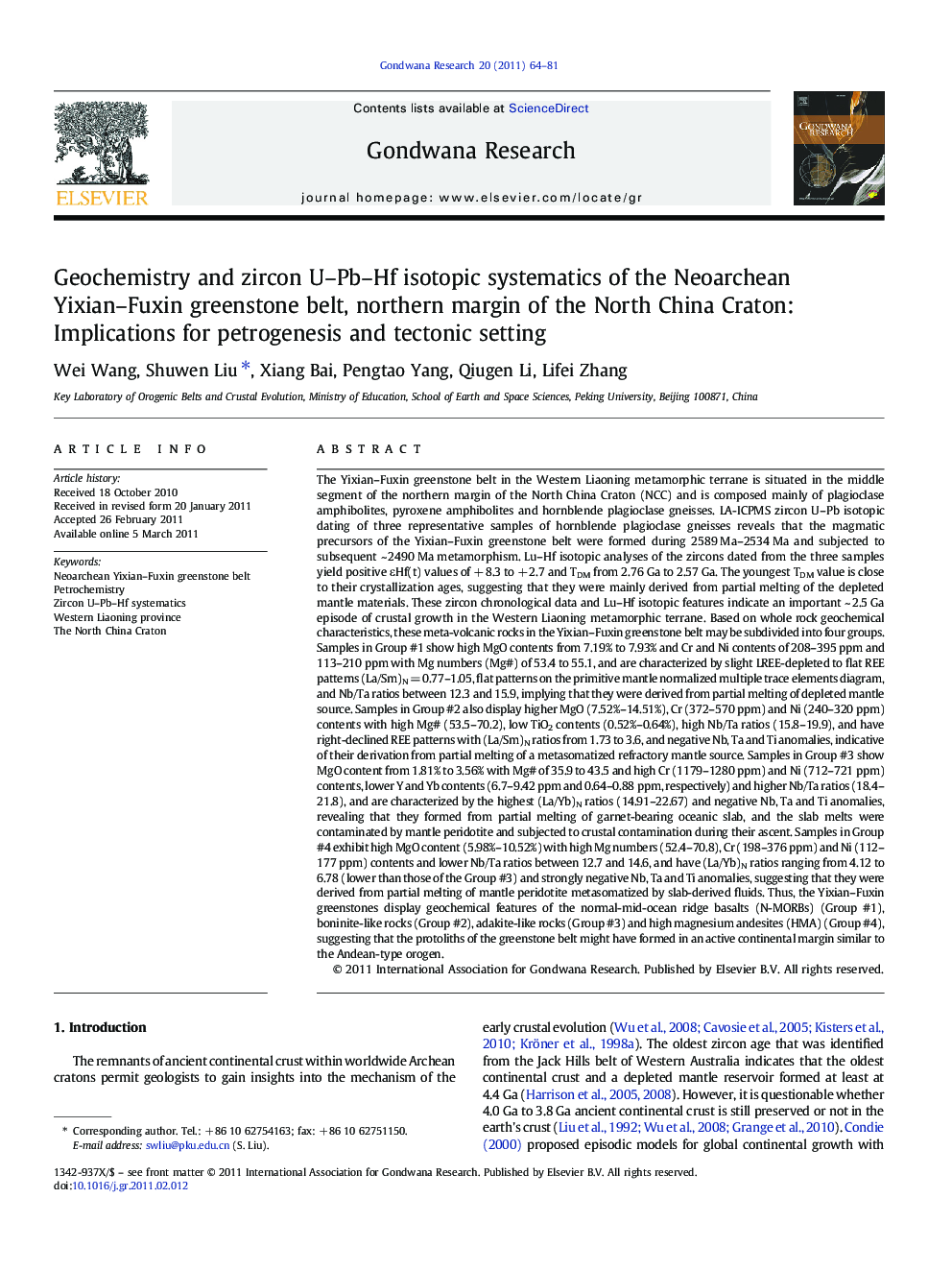| کد مقاله | کد نشریه | سال انتشار | مقاله انگلیسی | نسخه تمام متن |
|---|---|---|---|---|
| 4726944 | 1356354 | 2011 | 18 صفحه PDF | دانلود رایگان |

The Yixian–Fuxin greenstone belt in the Western Liaoning metamorphic terrane is situated in the middle segment of the northern margin of the North China Craton (NCC) and is composed mainly of plagioclase amphibolites, pyroxene amphibolites and hornblende plagioclase gneisses. LA-ICPMS zircon U–Pb isotopic dating of three representative samples of hornblende plagioclase gneisses reveals that the magmatic precursors of the Yixian–Fuxin greenstone belt were formed during 2589 Ma–2534 Ma and subjected to subsequent ~ 2490 Ma metamorphism. Lu–Hf isotopic analyses of the zircons dated from the three samples yield positive εHf(t) values of + 8.3 to + 2.7 and TDM from 2.76 Ga to 2.57 Ga. The youngest TDM value is close to their crystallization ages, suggesting that they were mainly derived from partial melting of the depleted mantle materials. These zircon chronological data and Lu–Hf isotopic features indicate an important ~ 2.5 Ga episode of crustal growth in the Western Liaoning metamorphic terrane. Based on whole rock geochemical characteristics, these meta-volcanic rocks in the Yixian–Fuxin greenstone belt may be subdivided into four groups. Samples in Group #1 show high MgO contents from 7.19% to 7.93% and Cr and Ni contents of 208–395 ppm and 113–210 ppm with Mg numbers (Mg#) of 53.4 to 55.1, and are characterized by slight LREE-depleted to flat REE patterns (La/Sm)N = 0.77–1.05, flat patterns on the primitive mantle normalized multiple trace elements diagram, and Nb/Ta ratios between 12.3 and 15.9, implying that they were derived from partial melting of depleted mantle source. Samples in Group #2 also display higher MgO (7.52%–14.51%), Cr (372–570 ppm) and Ni (240–320 ppm) contents with high Mg# (53.5–70.2), low TiO2 contents (0.52%–0.64%), high Nb/Ta ratios (15.8–19.9), and have right-declined REE patterns with (La/Sm)N ratios from 1.73 to 3.6, and negative Nb, Ta and Ti anomalies, indicative of their derivation from partial melting of a metasomatized refractory mantle source. Samples in Group #3 show MgO content from 1.81% to 3.56% with Mg# of 35.9 to 43.5 and high Cr (1179–1280 ppm) and Ni (712–721 ppm) contents, lower Y and Yb contents (6.7–9.42 ppm and 0.64–0.88 ppm, respectively) and higher Nb/Ta ratios (18.4–21.8), and are characterized by the highest (La/Yb)N ratios (14.91–22.67) and negative Nb, Ta and Ti anomalies, revealing that they formed from partial melting of garnet-bearing oceanic slab, and the slab melts were contaminated by mantle peridotite and subjected to crustal contamination during their ascent. Samples in Group #4 exhibit high MgO content (5.98%–10.52%) with high Mg numbers (52.4–70.8), Cr (198–376 ppm) and Ni (112–177 ppm) contents and lower Nb/Ta ratios between 12.7 and 14.6, and have (La/Yb)N ratios ranging from 4.12 to 6.78 (lower than those of the Group #3) and strongly negative Nb, Ta and Ti anomalies, suggesting that they were derived from partial melting of mantle peridotite metasomatized by slab-derived fluids. Thus, the Yixian–Fuxin greenstones display geochemical features of the normal-mid-ocean ridge basalts (N-MORBs) (Group #1), boninite-like rocks (Group #2), adakite-like rocks (Group #3) and high magnesium andesites (HMA) (Group #4), suggesting that the protoliths of the greenstone belt might have formed in an active continental margin similar to the Andean-type orogen.
Figure optionsDownload as PowerPoint slideResearch Highlights
► Yixian–Fuxin greenstone belt was formed during 2589 Ma–2534 Ma.
► The greenstone belt was metamorphosed at ~2490 Ma.
► N-MORB-like, boninite-like, adakite-like rocks and high-Mg andesites are identified.
► They are most likely to be formed in an active continental margin.
Journal: Gondwana Research - Volume 20, Issue 1, July 2011, Pages 64–81